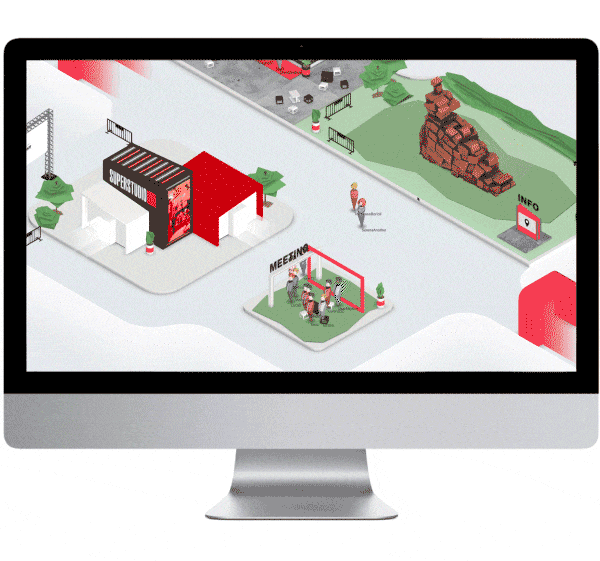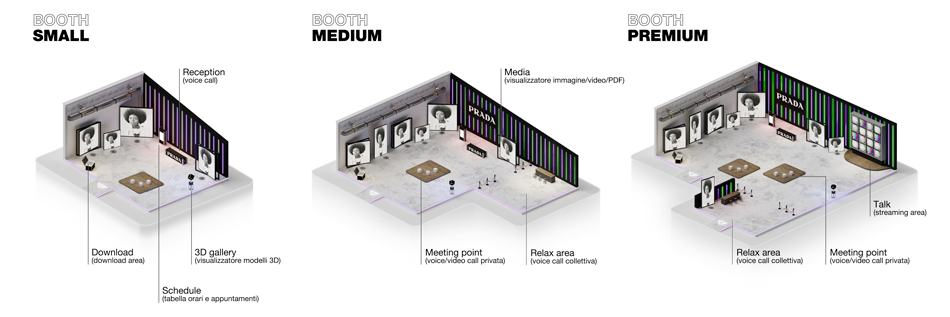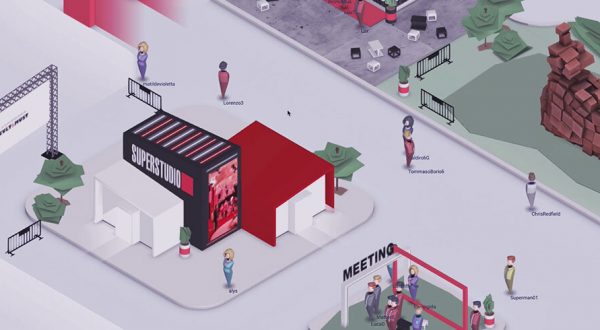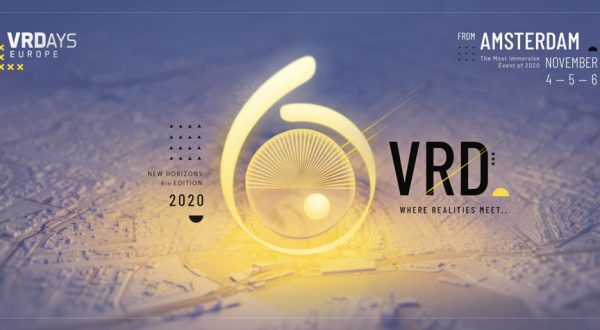Virtual events: Fairs and exhibitions will not stop, but they will take on a different form, in some ways more inclusive.
Virtual events: Welcome to the third place!
In November 2000, the launch of the PlayStation 2 was accompanied by a surreal and incomprehensible commercial, which concluded with a cryptic phrase: “Welcome to the third place.” The video was directed by the eclectic David Lynch, known for being the director of the TV series Twin Peaks and films like Mulholland Drive and Lost Highway. Many wondered what the third place was, a term that was still little used at the time and, in the language of community building, refers to that place that is neither home (the first place) nor the office (second place): the pub, a park, and, in Lynch’s vision for that commercial, the virtual world of games. It was a lonely world at the time, as online communities did not yet have the momentum they have today, but soon online interaction with other human beings would take over.
Today, the third place is increasingly represented online, particularly in online video games, a fact that is driving both the economies within virtual worlds and the spread of augmented reality and virtual reality systems. Research by ARK Invest estimates that the AR device market will grow from $1 billion in 2020 to $130 billion in 2030, with a significant acceleration starting in 2022. The same analysis shows some caution regarding virtual reality devices, which are still expensive and relatively unsophisticated at present.
Not just video games: events and jobs will also move online
Today, virtual worlds are mostly gaming experiences, but the landscape is rapidly changing, partly due to the Covid-19 pandemic. In just a few months, necessity has led companies and workers to abandon physical meeting rooms and, especially, live events, which have been replaced by virtual rooms in platforms like Microsoft Teams, Zoom, and similar tools. This trend will not dissipate when distancing measures are relaxed. Fairs and events will certainly continue, and even more likely, they will assume a different form, in some ways more inclusive. In addition to participants physically attending the event, there will be others participating virtually, and remotely.
However, to achieve this, new purpose-built digital platforms are needed. These platforms should be intuitive, effective, and above all, immersive, capable of bridging the gap between physical and remote participants. These platforms will represent a real turning point compared to the experiments conducted so far, which have been unable to provide an adequate user experience. The limitations are primarily related to unintuitive interfaces and a lack of device agnosticism: the experience tends to vary greatly depending on whether one is using a computer, smartphone, or tablet.
The future of events and new challenges for UX: AnotheReality’s vision
During the pandemic, the demand for virtual event platforms has grown immensely, and AnotheReality has supported many of its clients by developing projects that meet their needs. Working on concrete cases, it has been easy to understand the limitations of both the current market offerings and the structure of events themselves, as well as important usability aspects. Realizing that in the case of hybrid events, with part of the audience present physically and others connected remotely, certain aspects need to be rethought to make them accessible to everyone in the best possible way.
First and foremost, we need to consider physical spaces. While in a physical trade fair, one must deal with the limited exhibition areas, in metaverses, this limit does not exist. Therefore, it is possible to showcase more content, while ensuring accessibility (via smartphones) even for those physically present at the event, so as not to exclude them. But it is also necessary to rethink the concept of conferences within metaverses. Currently, we have relied on stopgap solutions that worked well during emergencies but also revealed their limitations in terms of engagement. The one-to-many model, where one or more speakers address an audience that merely spectates, is limited and needs to be surpassed. The current internal chat tools within platforms allow for a certain degree of interaction. However, if events are to be brought into metaverses, solutions that are both more engaging and intuitive need to be developed.
These are not trivial challenges to tackle from a technological standpoint, but even more so from a user interface perspective. UX design must be reimagined to ensure the success of these platforms. They should not only impress with graphics or possibilities but also be functional and intuitive, regardless of the device used to access them. They should help bridge the gap between physical and remote participants in the most natural way possible.
A new suite of tools for hybrid formats: Read more in-depth >
Next-generation virtual events and new platforms
The idea of organizing events in virtual reality, while fascinating, doesn’t work. Not only is it extremely expensive to send a headset to each participant, but also users may face difficulties in setting it up and using it correctly. Even if there were a magic wand to eliminate costs and complexity, it’s not guaranteed that VR would be the best solution. Ultimately, most events boil down to one or more speakers addressing an audience. That’s why, in most cases, many have solved the distance problem with simple video streams.
More can and must be done. The added value of participating in a professional event is not just listening to professionals seated in the audience but also building relationships, exploring demo areas, and, in the case of trade fairs, getting hands-on experience with the technologies being discussed. That’s why AnotheReality is working on an immersive, scalable, and user-friendly platform designed to make hybrid events more effective.
Within the platform, each user will be able to customize their avatar according to their preferences, making each user “unique” and usable for other events, as long as they rely on the same solution. This avatar can then freely navigate within the exhibition spaces, “walking” from one booth to another or simply “teleporting” thanks to integrated functions. The entire world is created in 3D, but the choice has been made to offer users an isometric view to simplifying usage as much as possible.

Why focus on 3D then? The reason is scalability: Currently, the platform doesn’t support virtual or augmented reality headsets, but when these become the norm, the system will already be ready to use them without having to rewrite everything from scratch.
Even without the headset, however, all the key functions are already available to ensure an experience more similar to attending an event in person. For example, there is a chat system (group or private) and meeting points are available, which are equivalent to reserved areas where professionals can hold private meetings while respecting privacy.
Each company can also customize its booth, offering remote participants an experience very close to being physically present. Although they won’t be able to touch the showcased products, 3D object visualizations are supported, allowing virtual rotation and manipulation.

Therefore, a platform for hybrid and virtual events is being developed—an open platform that can be adopted by anyone who wishes, similar to existing video communication solutions. In this perspective, avatar customization is not just a mere whim; it allows users to create their own virtual identity and use it for all their meetings.
In the end, events are about meeting, exchanging opinions, and networking, and if one cannot be physically present, participating with their avatar adds significant value.


